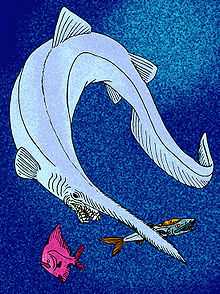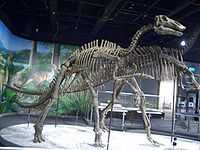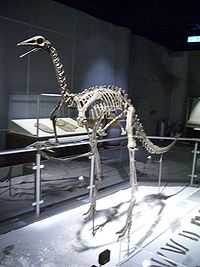Bissekty Formation
| Bissekty Formation Stratigraphic range: Turonian–Coniacian | |
|---|---|
| Type | Geological formation |
| Underlies | Aitym Formation |
| Overlies | Dzheirantui Formation |
| Lithology | |
| Primary | Sandstone |
| Other | Conglomerate |
| Location | |
| Region | Asia |
| Country |
|
The Bissekty Formation (sometimes referred to as Bissekt) is situated in the Kyzyl Kum desert of Uzbekistan, and dates from the late Cretaceous Period. Laid down in the early the Turonian to Coniacian stages, it is dated to about 90-85 ma (million years ago).
The Bissekty Formation is characterised by a mix of marine, brackish, freshwater, and terrestrial animal fossils. This stands in contrast the strictly marine fossils found in the underlying Dzheirantui Formation, and indicates that the Bissekty was formed during the regression of a saltwater sea. The coastline expanded inland again in the upper portion of the Bissekty, represented by a proportional increase of fully aquatic species, which were almost completely absent from the middle period of the formation. Semi-aquatic species remained abundant during this middle period, and the geology of the formations indicates that a braided river system took the place of the coastline. Eventually the area was again completely underwater, during the time period represented by the later Aitym Formation, which preserves coastal marine sediments.[1]
Invertebrate paleofauna
An indeterminate species of marine coral.
Arthropods
| Arthropods of the Bissekty Formation | ||||||
|---|---|---|---|---|---|---|
| Genus | Species | Location | Stratigraphic Position | Abundance | Notes | |
|
Linuparus dzheirantuiensis |
||||||
Molluscs
An indeterminate species of marine placenticeratid ammonite. An indeterminate species of marine teredinid shipworm. An indeterminate marine trigoniid bivalve. An indeterminate marine veneroid bivalve.
| Molluscs of the Bissekty Formation | ||||||
|---|---|---|---|---|---|---|
| Genus | Species | Location | Stratigraphic Position | Abundance | Notes | |
|
Crassatelites |
Indeterminate |
A marine crassatellid bivalve. | ||||
|
Mytiloides |
Mytiloides labiatus |
a marine inoceramid bivalve. | ||||
|
Indeterminate |
A marine limoid bivalve. | |||||
|
Quadratotrigonia |
Indeterminate |
A marine trigoniid bivalve. | ||||
|
Xylophaga |
Indeterminate |
An indeterminate species of marine shipworm. | ||||
Vertebrate paleofauna
The Bissekty Formation is notable for preserving the most abundant Turonian land animal fossils in Eurasia, and the most diverse fauna of Late Cretaceous eutherians (placental mammals and relatives) in the world.[1]
Listings and accompanying information are based on a survey of the Bissekty Formation published by Cory Redman and Lindsey Leighton in 2009 unless otherwise noted.[1] Aquatic and semi-aquatic species are restricted to freshwater unless otherwise noted.
Amphibians
An indeterminate species of salamander-like albanerpetontid amphibian. An indeterminate gobiatid species.
| Amphibians of the Bissekty Formation | ||||||
|---|---|---|---|---|---|---|
| Genus | Species | Location | Stratigraphic Position | Abundance | Notes | |
|
Aralobatrachus robustus |
A frog. | |||||
|
Eoscapherpeton asiaticum |
A scapherpetontid salamander. | |||||
|
Gobiates sosedkoi |
A gobiatid frog. | |||||
|
Gobiates spp. |
Additional indeterminate species of Gobiates. | |||||
|
Itemirella cretacea |
A possible discoglossid frog. | |||||
|
Kizylkuma antiqua |
A possible discoglossid frog. Marine. | |||||
|
Mynbulakia |
Mynbulakia surgai |
A batrachosauroidid salamander. | ||||
Cartilaginous fish
| Cartilaginous fishes of the Bissekty Formation | ||||||
|---|---|---|---|---|---|---|
| Genus | Species | Location | Stratigraphic Position | Abundance | Notes | Images |
|
Cretodus |
Cretodus crassidens |
A cretoxyrhinid. Marine. |
 Scapanorhynchus rhaphiodon | |||
|
Heterodontus |
Indeterminate |
A bullhead shark. Marine. | ||||
|
Hispidaspis |
Indeterminate |
A sand shark. Tolerant of brackish water. | ||||
|
Indeterminate |
A hybodontid. Tolerant of brackish water. | |||||
|
Ischyrhiza serra |
A sclerorhynchid. Tolerant of brackish water. | |||||
|
Myledaphus |
Myledaphus tritus |
A rhinobatoid. Tolerant of brackish water. | ||||
|
Polyacrodus |
Indeterminate |
A polyacrodontid. Tolerant of brackish water. | ||||
|
Scapanorhynchus rhaphiodon |
A goblin shark. Tolerant of brackish water. | |||||
Crocodylomorphs
| Crocodylomorphs of the Bissekty Formation | ||||||
|---|---|---|---|---|---|---|
| Genus | Species | Location | Stratigraphic Position | Abundance | Notes | |
|
Kansajsuchus borealis |
A possible goniopholidid mesoeucrocodylian. | |||||
|
Indeterminate |
A goniopholidid mesoeucrocodylian tolerant of brackish water. | |||||
|
Tadzhikosuchus macrodentis |
A possible alligatoroid eusuchian. | |||||
|
Zholsuchus procevus |
A possible mesoeucrocodylian. | |||||
|
Zhyrasuchus angustifrons |
A possible eusuchian. | |||||
Lizards
An indeterminate gekkonid. An indeterminate priscagamid. An indeterminate scincid.
| Lizards of the Bissekty Formation | ||||||
|---|---|---|---|---|---|---|
| Genus | Species | Location | Stratigraphic Position | Abundance | Notes | |
|
Buckantaus |
Buckantaus crassidens |
A macrocephalosaurid. | ||||
|
Ekshmer |
Ekshmer bissektensis |
A priscagamid. | ||||
Mammals and other therapsids
An unnamed genus and species of zhelestid ungulatomorph.
| Mammaliaformes of the Bissekty Formation | ||||||
|---|---|---|---|---|---|---|
| Genus | Species | Location | Stratigraphic Position | Abundance | Notes | |
|
Aspanlestes |
Aspanlestes aptap |
A zhelestid. | ||||
|
Daulestes |
Daulestes inobservabilis |
An asioryctitherian. | ||||
|
Daulestes kezbe |
An asioryctitherian. | |||||
|
Daulestes kulbeckensis |
An asioryctitherian. | |||||
|
Unnamed |
An unnamed species of Daulestes. | |||||
|
Kulbeckia |
Kulbeckia kulbecke |
A zalambdalestid. | ||||
|
Unnamed |
An unnamed smaller species of Kulbeckia. | |||||
|
Paranyctoides |
Paranyctoides aralensis |
A eutherian. | ||||
|
Parazhelestes |
Parazhelestes mynbulakensis |
A zhelestid. | ||||
|
Parazhelestes |
Parazhelestes robustus |
A zhelestid. | ||||
|
Shalbaatar |
Shalbaatar bakht |
A symmetrodont. | ||||
|
Sulestes karakshi |
A deltatheroid. | |||||
|
Uzbekbaatar kizylkumensis |
A cimolodont. | |||||
|
Zhelestes |
Zhelestes temirkazyk |
A zhelestid. | ||||
Ornithischians
Indeterminate hadrosaurid remains are known from the Bissekty Formation.[2]
Color key
|
Notes Uncertain or tentative taxa are in small text; |
| Ornithischians reported from the Bissekty Formation | ||||||
|---|---|---|---|---|---|---|
| Genus | Species | Location | Stratigraphic position | Material | Description | Images |
|
A. archibaldi[2] |
Reclassified as Bissektipelta[3] |
| ||||
|
B. kysylkumensis[2] |
A hadrosaur | |||||
|
B. archibaldi[3] |
"Partial skull."[4] |
An ankylosaur | ||||
|
C. kyslkumensis |
"Fragmentary dentary, vetebrae, tibia."[5] |
|||||
|
G. kysylkumensis |
Reclassified as Bactrosaurus | |||||
|
T. tardabilis[2] |
A ceratopsian[6] | |||||
Plesiosaurs
| Plesiosaurs of the Bissekty Formation | ||||||
|---|---|---|---|---|---|---|
| Genus | Species | Location | Stratigraphic Position | Abundance | Notes | Images |
|
P.? sp. |
A possible species of Plesiosaurus. Marine, possibly tolerant of brackish water. |
|||||
Pterosaurs
| Pterosaurs of the Bissekty Formation | ||||||
|---|---|---|---|---|---|---|
| Genus | Species | Location | Stratigraphic Position | Abundance | Notes | Images |
|
Azhdarcho lancicollis |
Dzhara-Kuduk |
Taykarshinskaya unit |
An azhdarchid |
|||
Ray-finned fish
An indeterminate acipenserid. An indeterminate albulid (bonefish) species. An indeterminate albulid (bonefish) species. An indeterminate pholidophoriform species.
| Ray-finned fish of the Bissekty Formation | ||||||
|---|---|---|---|---|---|---|
| Genus | Species | Location | Stratigraphic Position | Abundance | Notes | Images |
|
Aidachar paludalis |
An ichthyodectiform tolerant of brackish water. |
 A living Amia. | ||||
|
Amia limosa |
A bowfin tolerant of brackish water. | |||||
|
Atractosteus turanensis |
A gar tolerant of brackish water. | |||||
|
Belonostomus aciculifer |
An aspidorhynchid. | |||||
|
Psephuroides |
Psephuroides kazakhorum |
A paddlefish. | ||||
Theropods
A possible oviraptorosaur, known from a single forelimb claw.[7] An unnamed ornithomimosaur, known from fragmentary remains.[8] An indeterminate tyrannosaurid species, known from isolated teeth.[9]
| Theropod dinosaurs reported from the Bissekty Formation | ||||||
|---|---|---|---|---|---|---|
| Genus | Species | Location | Stratigraphic position | Material | Description | Images |
|
Alectrosaurus sp. |
Fragmentary remains which may belong to juvenile Alectrosaurus, a tyrannosaurid.[7] |
| ||||
|
A. bissektensis |
"Metatarsals."[10] |
A possible species of Archaeornithomimus, an ornithomimosaur. | ||||
|
C. martinsoni |
"[Two] partial mandibles."[11] |
An oviraptorosaur. | ||||
|
E. asiaticus |
||||||
|
cf. Gallimimus sp. |
A possible ornithomimosaur or oviraptorosaur.[7] | |||||
|
Horezmavis |
H. eocretacea[citation needed] |
A possible gruiform. | ||||
|
I. medullaris |
||||||
|
K. mengi[14] |
"[Two] synsacra."[14] |
|||||
|
Paronychodon asiaticus |
A troodontid, known from isolated teeth. (Originally Euronychodon asiaticus)[15] A possible second species of Paronychodon is also known from the Bissekty Formation. | |||||
|
R. asiatica |
A possible dromaeosaurid. | |||||
|
Platannavis[2] |
P. nana[2] |
"Sacrum."[16] |
||||
|
Urbacodon sp. |
A troodontid, known from isolated teeth.[17] | |||||
|
Z. kashkarovi |
A possible ornithurine. | |||||
Enantiornithines
Color key
|
Notes Uncertain or tentative taxa are in small text; |
| Enantiornithines reported from the Bissekty Formation | ||||||
|---|---|---|---|---|---|---|
| Genus | Species | Location | Stratigraphic position | Material | Description | Images |
|
A. bonaparti |
A possible enantiornithine.[18] A possible second species of Abavornis in the Bissekty Formation is known from a partial coracoid.[18] |
| ||||
|
C. anachoretus |
A possible enantiornithine. | |||||
|
E. martini[2] |
"Coracoid."[19] |
|||||
|
E. walkeri[2] |
"Coracoid."[19] |
|||||
|
E. nessovi |
An enantiornithine. Possible third and fourth species of Explorornis in the Bissekty Formation are known from partial coracoids.[18] | |||||
|
E. walkeri |
||||||
|
I. minusculus |
"Dorsal vertebra."[16] |
An enantiornithine originally but incorrectly identified as a species of Ichthyornis.[20] | ||||
|
I. martini |
Known from a partial coracoid.[18] |
A possible enantiornithine.[18] | ||||
|
I. silvae |
Known from a partial coracoid.[18] |
A possible enantiornithine.[18] | ||||
|
K. cretacea[2] |
"Distal humerus."[19] |
An enantiornithine. | ||||
|
K. mengi |
"[Two] synsacra."[14] |
An enantiornithine. | ||||
|
L. maltshevskyi[2] |
"Synsacrum."[19] |
A possible enantiornithine. | ||||
|
cf. Nanantius |
An enantiornithine, similar to Nanantius eos. | |||||
|
S. prisca[2] |
"Distal tibiotarsus."[21] |
An enantiornithine. | ||||
|
Z. kashkarovi[2] |
"Synsacrum."[21] |
|||||
|
Z. logunovi[2] |
"Synsacrum."[21] |
|||||
Turtles
An indeterminate trionychid (soft-shell) turtle species that was tolerant of brackish water.
| Turtles of the Bissekty Formation | ||||||
|---|---|---|---|---|---|---|
| Genus | Species | Location | Stratigraphic Position | Abundance | Notes | |
|
"Adocus" |
"Adocus" aksary |
An adocid tolerant of brackish water. | ||||
|
Anatolemys |
Indeterminate |
A "macrobaenid" tolerant of brackish water. | ||||
|
Khunnuchelys |
Khunnuchelys kizylkumensis |
A trionychid tolerant of brackish water. | ||||
|
Lindholmemys |
Lindholmemys elegans |
A "lindholmemydid" tolerant of brackish water. | ||||
|
Shachemys |
Shachemys ancestralis |
An adocid tolerant of brackish water. | ||||
References
- ↑ 1.0 1.1 1.2 Redman, C.M. and Leighton, L.R. (2009). "Multivariate faunal analysis of the Turonian Bissekty Formation: Variation in the degree of marine influence in temporally and spatially averaged fossil assemblages." PALAIOS, 24(1): 18-26. doi:10.2110/palo.2007.p07-072r Supplementary information including faunal tables.
- ↑ 2.0 2.1 2.2 2.3 2.4 2.5 2.6 2.7 2.8 2.9 2.10 2.11 2.12 2.13 2.14 2.15 2.16 2.17 2.18 "Dinosaur distribution (Bissekty Formation)." Weishampel, et al. (2004). Pg. 594.
- ↑ 3.0 3.1 Aviarianov, A.O. (2002). "An ankylosaurid (Ornithischia: Ankylosauria) from the Upper Cretaceous Bissekty Formation of Uzbekistan." Bull. Inst. Roy. Sci. Nat. Belg. Sci. Terre, 72: 97-110.
- ↑ "Table 17.1," in Weishampel, et al. (2004). Page 367.
- ↑ "Table 20.1," in Weishampel, et al. (2004). Page 442.
- ↑ Sues, H.-D., and Averianov, A. (2009). "Turanoceratops tardabilis—the first ceratopsid dinosaur from Asia." Naturwissenschaften, doi:10.1007/s00114-009-0518-9.
- ↑ 7.0 7.1 7.2 Nesov, A. (1995). "Dinosaurs of Northern Eurasia: new data about assemblages, ecology and paleobiogeography." Scientific Research Institute of the Earth's Crust. St. Petersburg State University, St. Petersburg, Russia: 156 pp. + 14 pl. [in Russian with short English, German, and French abstracts].
- ↑ Averianov. (2007). "Theropod dinosaurs from Late Cretaceous deposits in the northeastern Aral Sea region, Kazakhstan." Cretaceous Research, .
- ↑ Archibald, Sues, Averianov, King, Ward, Tsaruk, Danilov, Rezvyi, Vereterunikov and Khodjaev. (1998). "Precis of the Cretaceous paleontology, biostratigtaphy and sedimentology at Dzharakuduk (Turonian?-Santonian), Kyzylkum Desert, Uzbekistan." Bulletin of the New Mexico Museum of Natural History and Science, 14: 21-27.
- ↑ "Table 6.1," in Weishampel, et al. (2004). Page 139.
- ↑ "Table 8.1," in Weishampel, et al. (2004). Page 166.
- ↑ "Table 10.1," in Weishampel, et al. (2004). Page 199.
- ↑ "Table 9.1," in Weishampel, et al. (2004). Page 185.
- ↑ 14.0 14.1 14.2 14.3 "Table 11.1," in Weishampel, et al. (2004). Page 212.
- ↑ Nesov, A. (1995). Dinozavri severnoi Yevrasii: Novye dannye o sostave kompleksov, ekologii i paleobiogeografii [Dinosaurs of Northern Eurasia: new data about assemblages, ecology and paleobiogeography]. Scientific Research Institute of the Earth's Crust, St. Petersburg State University, St. Petersburg, Russia: 156 pp. + 14 pl. [in Russian with short English, German, and French abstracts].
- ↑ 16.0 16.1 "Table 11.1," in Weishampel, et al. (2004). Page 216.
- ↑ Averianov, A.O.; and Sues, H.-D. (2007). "A new troodontid (Dinosauria: Theropoda) from the Cenomanian of Uzbekistan, with a review of troodontid records from the territories of the former Soviet Union". Journal of Vertebrate Paleontology 27 (1): 87–98. doi:10.1671/0272-4634(2007)27[87:ANTDTF]2.0.CO;2.
- ↑ 18.0 18.1 18.2 18.3 18.4 18.5 18.6 18.7 Panteleev. (1998). "New species of enantiornithines (Aves: Enantiornithes) from the Upper Cretaceous of Central Kyzylkum." Russkii Ornitologicheskii Zhurnal, Ekspress-vy.pvsk 35: 3-15.
- ↑ 19.0 19.1 19.2 19.3 "Table 11.1," in Weishampel, et al. (2004). Page 213.
- ↑ Kurochkin. (1996). "A new Enantiornithid of the Mongolian Late Cretaceous, and a general appraisal of the Infraclass Enantiornithes (Aves)." Russian Academy of Sciences, special issue: 50pp.
- ↑ 21.0 21.1 21.2 "Table 11.1," in Weishampel, et al. (2004). Page 214.


